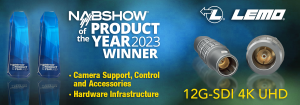Achieving 4K/UHD without Moving to IP: How We Made it Possible
Written by Linda White

Sometimes creating a full-blown network just to connect a computer and printer is overkill. In other words: Depending on what you need, it’s possible to overdo your technology and/or infrastructure.
In broadcasting, for example, viewers may be demanding 4K resolution – but not every production calls for IP in order to transmit 4K/UHD signals.
When 4K/UHD was first introduced to broadcasting – promising four times the resolution of 1080p – existing coax cables and SDI technology (a digital video interface standard used since the early ’90s) couldn’t support it in a single link. 4K resolution used in production and digital cinema called for higher bandwidth, resolution and pixels than what coax could support. Instead, IP and fiber became the preferred method of achieving 4K quality for production and UHD for broadcast signal transmission.
The only way around this was to use four coax cables – each supporting 3 GHz – to send one 12 GHz UHD signal (this is referred to as a quad-link configuration).
This fix may have gotten the job done in terms of transmitting 4K/UHD signals, but it was expensive, bulky and cumbersome for broadcasters to manage. Quad-link configurations take up lots of space, max out weight limitations in mobile applications and increase cable expenses by requiring four cables for a single link.
Although some very large broadcasters and media companies were able to make the move to IP or fiber right away to support 4K/UHD signals, smaller broadcasters across the country were left in a bind. They, too, wanted to provide viewers with high resolution and 4K/UHD content – but weren’t quite ready to make the move financially.
After hearing from a number of broadcasters about their frustrations with this dilemma, we knew there must be a way to help them find middle ground. And that’s where Belden’s 4K UHD Coax Cable for 12G-SDI enters the picture.
This cable supports a bandwidth of 12 GHz and maximizes 4K/UHD transmission distance over a single link, decreasing the bulk and expense associated with dual-link and quad-link configurations. The 4K UHD Coax Cable for 12G-SDI also exceeds return loss specifications for the performance required for such high-speed signals.
Using this solution, broadcasters can now continue using SDI standards and coax cable instead of IP or fiber solutions – while still achieving a 4K/UHD picture (and without dealing with four cables to transmit one signal).
Instead, broadcasters simply plug in one coax to send a high-quality, 4K/UHD signal. Instead of rushing to take on a new level of broadcasting complexity, this innovation allows them to shift to IP or fiber when they’re ready – and when it makes financial sense to do so.
Creating the cable was only one part of the equation, however: Equipment manufacturers also had to be ready to support the required connections. Although many broadcasters wanted to use the cable, much of the camera and broadcast equipment on the market lacked I/O to accommodate it.
To make this happen, production and broadcast leaders sent an open letter to equipment manufacturers with a plea: to include 12G-SDI ports as standard features on all video equipment capable of working in 4K/UHD mode.
As a result, if you take a close look at today’s broadcast equipment used around the world, you’ll find 12G-SDI ports integrated to support this innovation that began with Belden. Broadcasters now have a way to give viewers the resolution they want without having go compromise on quality, embark on a complete technology overhaul or make a large capital investment.
Find the original article here




